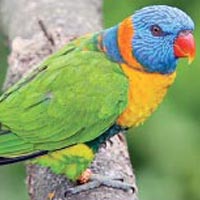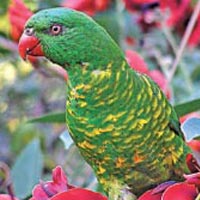|
Nature trail:

Amajority of our feathered friends from the avian world never fail to
fascinate us with their beautifully coloured plumage, striking beaks,
talons and unusual
 habits... habits...

Today we like to introduce you to a species of vibrantly hued
feathered friends who are bound to take your breath away if you ever
happen to come across them in the natural habitats in their native land
or even in an avian sanctuary... Dressed in almost every captivating
colour of the rainbow these little birds aptly named Rainbow Lorikeets (Trichoglossus
haematodus ) belong to the Psittacidae (parrot) family.
The Rainbow Lorikeet is among the most spectacular and variable of
the group, with 21 races scattered over the southwestern Pacific. Most
races of this 150-gram (five-ounce) species have red bills, blue heads,
green wings, and black feet, though the colour and pattern of the chest,
neck, and belly vary dramatically. The males and females are similar in
plumage, but the female is smaller and has a shorter bill. The general
plumage is very colourful with green, blue, black, red and yellow, but
there is a lot of variation between the different sub-species (20
sub-species).
The legs are generally grey and the bill and iris are red in Rainbow
Lorikeets. Immature birds have a duller plumage than the adults, a
black-brown bill and brown iris. They are vividly coloured with a
brilliant blue head and red bill. Their backs are bright green with a
lighter collar at the top. Their fronts are orange with blue at the
bottom. They can be confused with a Red-Collared Lorikeet which differs
mostly in the collar colour.
The markings of the best known subspecies T. h. moluccanus are
particularly striking. Rainbow Lorikeets are not large birds, with the
length ranging from 25-30cm (9.8-11.8 in). The average total length from
tip of the bill to the tip of the tail is about 26 cm. The wingspan is
about 17cm (6.7 in). The Scaly-breasted Lorikeet (T. chlorolepidotus )
and the Red-collared Lorikeet (T. rubritorquis ) also belong to the same
genus.
Rainbow Lorikeets are very active and noisy birds . These brightly
coloured parrots are fast fliers and have rapid wing beats. They often
fly in large flocks and are very noisy. Around sunset they are known to
screech and fly around before roosting. They usually roost in tall
eucalypts.

These birds feed mainly on flowers, nectar and fruit. The lorikeets
have a brush on the end of their tongue to help with sipping up nectar
and pollen. The females produce two or three white, oval-shaped eggs,
but a pair can produce up to three broods in a season.
The female incubates the eggs for about 25 days. The father lorikeet
also spends time in the nesting hollow. The young leave the nesting
hollow for the first time after 7-8 weeks, returning to roost for the
first few weeks.
Rainbow Lorikeets have been introduced to Perth, Western Australia,
Auckland, New Zealand and Hong Kong.
***********
*********** *********** *********** ***********
*********** *********** *********** ***********
Relative in the same
Genus
 Olive-headed
Lorikeet Olive-headed
Lorikeet
The Olive-headed Lorikeet (Trichoglossus euteles), also called the
Perfect Lorikeet, is found in forests, woodlands and cultivated areas on
Timor and smaller nearby islands. The Olive-headed Lorikeet is a mainly
green parrot about 24 cm (9.5 in) in size.
 Ornate
Lorikeet Ornate
Lorikeet
The Ornate Lorikeet (Trichoglossus ornatus ), a monotypic species of
parrot in the Psittacidae family is endemic to Sulawesi and nearby
smaller islands in Indonesia. It is found in forests, woodlands,
mangroves and plantations, and is locally common. The Ornate Lorikeet is
a mainly green parrot...
Yellow-and-green Lorikeet
The Citrine Lorikeet (Trichoglossus flavoviridis ) or
Yellow-and-green Lorikeet is endemic to Sulawesi and the Sula Islands in
Indonesia. It is found in forests and woodlands at altitudes up to 2400
m. It is generally common.
 Red-collared
Lorikeet Red-collared
Lorikeet
The Red-collared Lorikeet, Trichoglossus rubritorquis , is found in
wooded habitats in northern Australia (north-eastern Western Australia,
northern Northern Territory and far north-western Queensland). It is
sometimes considered a subspecies of the Rainbow Lorikeet.
Pohnpei Lorikeet
The Pohnpei Lorikeet (Trichoglossus rubiginosus ) is endemic to the
island of Pohnpei and the nearby Ahnd Atoll in Micronesia. Historically
the species also occurred on Namoluk Atoll near Chuuk.
 Scaly-breasted
Lorikeet Scaly-breasted
Lorikeet
The Scaly-breasted Lorikeet (Trichoglossus chlorolepidotus ) is found
in the woodlands in eastern Australia. The common name aptly describes
this bird, which has yellow breast feathers broadly edged with green
that look like scales.
Mindanao Lorikeet
The Mindanao Lorikeet or Mount Apo Lorikeet (Trichoglossus
johnstoniae ), known in French as loriquet de Johnstone and in Spanish
as lori de Mindanao are two very similar subspecies, which are both
endemic to Mindanao , Philippines.
Fast facts
Lories and lorikeets are small to medium-sized arboreal parrots
characterised by their specialised brush-tipped tongues for feeding on
nectar and soft fruits. The species form a monophyletic group within the
parrot family Psittacidae |

